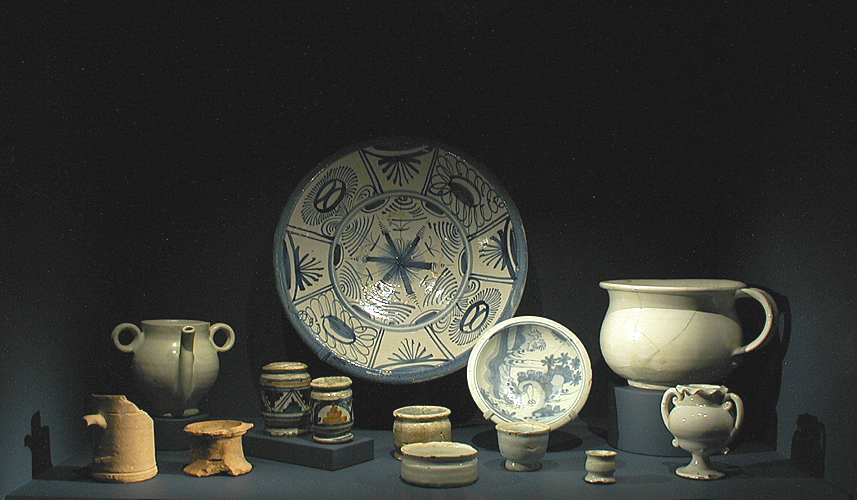
…Making Vessels for
Apothecaries and others very artificially.
John Stowe, A Survey of London, 1633 ed.
Immigrant Dutch potters began making delftware in the London area in 1570,
but after 1614, the principal area of production lay across the Thames River
in the notorious Borough of Southwark. By the end of the century, the craft
had spread westward to Vauxhall and Lambeth where production continued for
another hundred years.
Known in the seventeenth century as galleyware, the thickly white-glazed earthenware
required two firings, the first at a high temperature to create the stage
defined as biscuit (1 and 2). It was then coated with a lead glaze, made white
and opaque by the addition of tin, and hand-painted before being fired again
at a lower temperature.
Although all surviving delftware from the first years of production is painted
in one or more colors (3, 4 and 5), by about 1630, utility wares were being
sold unpainted. These ranged from ointment jars to caudle pots and later to
washbasins and chamber pots, whose production continued to the end of the
eighteenth century.
13. Chamber pot, delftware. Probably
Lambeth, ca. 1690–1720.
12. Vase, delftware. England or
the Netherlands, ca. 1680.
11. Dish, cobalt-decorated delftware.
Possibly Vauxhall, ca. 1680–1690.
10. Ointment pot, delftware. Southwark,
ca. 1640 – 1700.
9. Ointment pot, delftware. Southwark,
ca. 1640 – 1700.
8. Ointment pot, delftware. Southwark,
ca. 1640 – 1700.
7. Ointment pot, delftware. Southwark,
ca. 1640 – 1700.
6. Caudle or posset pot, delftware.
Southwark, ca. 1640–1660. Lent by the Chipstone Foundation, NH2000.74,
gift of Carol and Ivor Noël Hume.
5. Charger, delftware. Southwark,
ca. 1640–1660.
4. Apothecary pot, delftware. Southwark,
ca. 1620–1640.
3. Apothecary pot, delftware. Southwark,
ca. 1620–1640.
2. Salt, biscuit-fired earthenware.
Southwark, ca. 1630–1660.
1. Mug, biscuit-fired earthenware.
Southwark, ca. 1630–1660.

